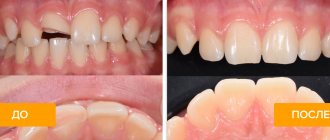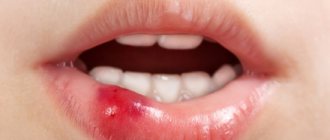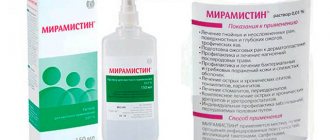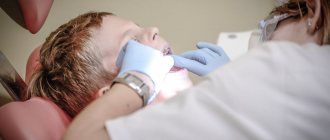Home / Articles / Broken tooth – what to do
Dental injuries are not uncommon in childhood. Children's activity takes its toll. Having discovered a defect, parents wonder what to do if their child has a broken tooth. An unpleasant situation can happen for various reasons. This often occurs due to weakened enamel. Part of a child's tooth can break off at the most inopportune moment, for example, when the baby bites off something hard.
The front teeth are at greatest risk. Because of this, the smile deteriorates. Pediatric dentistry today allows you to find a solution regardless of the complexity of the problem. In most cases, a broken tooth can be restored. For this purpose, modern techniques and the latest technologies are used.
See types and prices for dental prosthetics
Causes of dental injury
A large or barely noticeable gap in the teeth area spoils the entire appearance. To treat and restore a tooth, you need to know the main causes of dental injury. There are several of them.
1. Mostly, children receive mechanical injuries from a fall or bruise, when parents see, for example, that a front tooth has broken at the root.
2. Children's teeth are not yet strong enough to experience serious jaw load. Therefore, it is worth making sure that children do not get used to, for example, clenching their teeth tightly.
3. If half of the tooth crown is broken, it is due to a poor-quality filling.
4. The filling or inlay may pop out or break when it reaches the end of its service life.
5. Teeth with thinned enamel become a risk area.
6. Due to thinned enamel, the tooth may be destroyed due to carious formation.
7. The quality and properties of food also affect tooth decay.
Avoid giving children foods that are too hard or rough. Even seeds can cause a piece of a tooth to break off. To avoid all these unpleasant consequences, you will need to pay more attention to care, as well as the quality of food.
To strengthen tooth enamel, you need a sufficient amount of calcium in the body. To strengthen the structure, remineralization is required. The appearance of microcracks is due to the fact that the child receives food that is too contrasting. This affects the condition of the enamel, it becomes vulnerable. A weakened tooth may break at some point. This is the result of exposure to food and ingestion of hot and frozen drinks.
Methods for restoring a broken front tooth
What to do if your front tooth is broken? The specific restoration method is chosen by the dentist, taking into account the type of fracture, the amount of damage and other factors. The direct method involves restoration directly in the patient's mouth. This usually only requires one visit to the dentist. In this case, various composite materials are used that completely match the color of neighboring tissues, so the intervention of a specialist will not be noticeable.
| Pros of the direct method | Disadvantages of the direct method |
|
|
During indirect restoration, missing parts are replaced with prefabricated prostheses. This technique allows you to restore large defects, for example, when a large piece of a front tooth has broken off. Most often, the doctor uses the following types of prostheses:
- Veneers. They are thin plates that are matched to the color of the tooth. Veneers have different thicknesses and can be installed both with enamel turning and without turning (Hollywood veneers). Strong cement is used for fixation. Veneers are suitable for repairing small chips in enamel, but they do not correct the defect itself. This method can only hide a broken front tooth.
- Crowns. One of the most popular types of prostheses that have been used in dentistry for a long time. A crown is placed on a broken front tooth in cases where the amount of damage is very large and a significant part of it is missing. Crowns are made from various materials: metal, ceramics, metal-ceramics, zirconium dioxide, etc. The best option in terms of price/quality ratio is metal-ceramics, and for patients who need the most aesthetic result, ceramics and zirconium dioxide are perfect. The crown can be fixed to a previously prepared stump or an installed pin (implant).
- Bridge. This type of prosthesis is obtained by soldering together several single crowns. In order to install it, it is necessary to prepare one tooth on both sides of the defect. Thus, if a patient has two broken front teeth, the bridge will consist of four crowns. It is also possible to make a prosthesis from three crowns per tooth, which is used more often.
Among the advantages of the indirect method are the ability to restore extensive damage, good aesthetic results, and high resistance to heavy loads. The disadvantages will be the high cost of the technique, the need for preparation, and in some cases, depulpation of the tooth, and the impossibility of correcting the defect in one day.
Typology of dental trauma
If a piece of a tooth breaks, the fragments can trap the enamel when destroyed. In these cases, the tooth breaks open or closed, and the pulp may open. Tooth injuries are distinguished by the area of the fracture - at the root, on top, etc. In case of injury, when a piece may break off, the tooth is often displaced.
The nature of the damage depends on the size of the chipped part, for example, if a child’s upper wisdom tooth is half broken:
- minimal degree of injury;
- average degree of injury;
- severe degree of injury.
When a tooth is damaged, the enamel is often affected. This is a minimal type of injury when the internal layers are not affected. The opposite indicates the average severity of the tooth fracture. In such a situation, the damage touches the pulp and the nerve is affected.
Let's look at the main types of dental damage. This is important for understanding what to do if a piece of a tooth breaks off.
1. The tooth broke in the root zone . The child’s tooth root is not yet strong enough to be difficult to remove.
The greatest risk, as always, falls on the upper front incisors. In order to determine why a child’s baby tooth has broken off, modern diagnostics will be required. A tooth fracture in the root area is determined by a series of x-rays. It is detected, as a rule, with the appearance of characteristic sensations due to inflammation of the gums. Depending on the degree of root destruction, the pulp will be affected, and this already leads to more serious consequences.
2. If a front tooth breaks off, and it is a baby tooth . Most often, a small piece breaks off from a small tooth. This can happen for various reasons. The doctor will determine the degree of danger. If the crown under the root is broken, the tooth will have to be removed. When a tooth chips away from the root, cosmetic restoration can be used to solve the problem. Usually the dentist performs extensions.
Often a tooth is displaced or dislocated as a result of a side blow to the jaw. For example, a child hit something when falling or another child accidentally touched it, and your child’s front tooth broke off. As a result, gum swelling may occur. The entry of microbes into the wound leads to the loss of a tooth, even if it is a milk tooth. It can be restored, but to do this it must be preserved in warm milk or saline until the implantation procedure.
If a child knocks out a baby tooth, what should you do?
In a situation where a child breaks a tooth at the age of 1, there is no need to panic. You need to calm the child, pick him up, examine the oral cavity and try to find a broken or knocked out tooth. If it comes out intact with the root, it is necessary to protect the wound from infection by applying a sterile swab. For prevention, you should see a dentist. If a small piece is broken off, and even more so a red dot is visible, you need to immediately go to the dentist and have treatment. The procedure will be similar for older children with trauma to their baby teeth.
Now let's consider another situation. A wisdom tooth chipped into the gums - what to do?
If a tooth breaks or falls out, do not treat the area with peroxide, alcohol, touch the wound, or brush with a toothbrush. In a situation where there is a suspicion of not just a broken tooth, but also a broken jaw, she needs to be provided with peace and immobilized. To do this, you will need to make a bandage passing through the top of the head.
Severe trauma to the jaw can lead to nosebleeds. In this case, it is necessary for the child to lower his head and place a cold compress on the bridge of his nose. At the same time as these actions, someone should call the doctor.
After identifying the nature of the damage in the hospital using an X-ray, it will be possible to determine how damaged the surrounding tissues are, whether there are dislocations or subluxations.
Tooth dislocation in a child
It is not always possible to determine a dislocation on your own. Parents are required to examine the baby after an injury. If the tooth is rotated or tilted, there is no need to try to put it back in place. This way you can hurt the child. You need to see a doctor as soon as possible. He will determine the condition of the tooth root and decide whether to remove it or save it.
At the same time, if the crown is visually intact, it is possible that the root could have broken as a result of injury. This damage is not visible upon inspection. It can only be determined by an x-ray in a clinic. In some cases, it is possible to save the tooth and avoid removal.
Possible complications
Complex injuries can often have serious consequences, manifested in complications. It doesn’t matter which tooth was injured – the front incisor, the chewing tooth. After the examination, the doctor will decide how to save the child’s tooth. If you neglect the recommendations of a specialist, this can lead to more serious consequences, not to mention aesthetics.
Types of complications
1. Possibility of infection of the pulp area.
2. Increased tooth sensitivity.
3. The appearance of a bend in the tooth root.
4. Violation of occlusion.
5. Formation of cysts and granulomas.
You need to prepare for the fact that a damaged child’s tooth will begin to change the angle of development. And this leads to deformation not only of the damaged tooth, but also of its healthy neighbors. If it is necessary to remove a broken tooth, the space must be filled with an implant. If filling is not carried out, other teeth will begin to shift and move closer together, which leads to occlusion disorders - bite.
Types of root fractures
Dentists call several types of dental fractures:
- Transverse
(horizontal). The fracture is parallel to the cutting edge or chewing area. - Vertical
(longitudinal). Extent along the longitudinal axis of the crown. - Oblique
- a variant of the vertical one. The contour is at an angle to the tooth axis. - Splintered
. The presence of several fault lines.
The type of defect is visible in the picture. In the last two cases, removal is indicated, but in the first, there is a chance to restore the tooth.
Transverse fracture
The level of fracture and unit loosening varies. If the root of the tooth is broken in the apex area, then mobility is minimal. The intensity of the symptoms is determined by the damage to the pulp: when the integrity of the neurovascular bundle is damaged, sharp pain impulses will follow after pressing or biting. Is the fracture line in the middle of the root? The mobility is palpable.
Vertical root fracture
Such a tooth root fracture is difficult to diagnose in the early stages, but the clinic has advanced equipment that allows us to identify the defect. Previously, such a diagnosis was fatal, but in some episodes (for example, an incomplete fracture - a crack in the root of a tooth), restoration is possible with the help of special composite cements or innovative compositions. But in most cases, a longitudinal root fracture means that the tooth must be removed followed by implantation or other prosthetics.
What are the dangers of dental injuries?
Tooth decay is associated with damage to internal tissues. If caries is not treated in time, damage to the pulp - the core of the tooth with the presence of nerves and blood vessels - will occur. And then – the inflammatory process. The child will begin to feel constant toothache and complain about his health. The inflammatory process will affect different areas. In children, pulp periodontitis develops due to inflammation. This is due to the fact that the roots of a child’s tooth develop and strengthen over a long period of time, so damage occurs faster.
Damage to hard dental tissues
- Ifraction of enamel. It is a crack on the surface of the tooth without loss of dental tissue.
- Fracture within the enamel. Belongs to the category of chips without complications, but with the loss of some tissue.
- Enamel-dentin fracture. The fracture has no complications, and is distinguished by the passage of the chip line simultaneously along the enamel and dentin. Part of the dental tissue is lost.
- Enamel-dentin-pulp fracture. Refers to the number of fractures with complications, which result in exposure of the pulp.
How to restore a damaged area?
A child with a chipped tooth should be taken to the dentist immediately. The doctor will fill the canals in the exposed pulp and remove the nerve bundle. In general, different methods and technologies are used today to restore and preserve teeth.
- For a broken tooth, dental crowns are used.
- The doctor can place veneers for children.
- When a tooth is broken or chipped, your doctor may place baby inlays.
The use of a crown is advisable when a tooth in the upper row of incisors is broken or when the chewing teeth are damaged. But at the same time, processing (grinding) is carried out on neighboring ones.
You can restore your front teeth thanks to thin onlays - veneers, which can be matched to the rest of your teeth. If a tooth is broken and cannot be restored, the doctor will clean the canals and install an inlay (implant).
With the help of intracanal pins, it is possible to restore a chipped tooth if the parents decided to save it. With this method of dentures, aesthetics are preserved as much as possible. The operation will not affect the bite or chewing function.
Symptoms
To suspect that a child has broken a front tooth is quite simple:
- Violation of the shape and integrity of the dental crown. Upon examination, you may notice a chipped tooth and a defect;
- Appearance of a crack. Characteristic of an incomplete fracture, part of the tooth may wobble, but not break off;
- Strong pain. The pain can be localized in the tooth, gum, or even spread to the entire jaw, depending on the severity and nature of the injury. Pain in the jaw occurs with impacted fractures, which are most often the result of trauma. Young children who cannot say what happened begin to cry and refuse food;
- Swelling, redness, bleeding of the gums. In some cases, the fracture is also accompanied by injuries to the soft tissues of the oral cavity. In severe cases, pathological mobility of adjacent teeth may appear.
Prevention of tooth decay
We must try to avoid serious dental problems and prevent situations where a child could be injured or break a tooth. Parents should try to minimize all risks. To do this, it is enough to apply a few simple rules in practice.
For proper growth and development of bones and teeth, it is necessary to provide the child with complete, high-quality nutrition. Then the body will receive the entire complex of necessary micronutrients, vitamins, and substances.
When the baby has all his milk teeth, around the age of three, it would be good to give him more solid food. Various vegetables, fruits, and crackers are suitable for this. This way the child will become accustomed to more adult food, which will strengthen his teeth.
To maintain healthy teeth, you need to pay attention to the development of the child’s chewing muscles; for this, you should control the consistency of food.
It is important to teach your child to brush his teeth and instill the good habit of visiting the dentist periodically.
View prices
Making an appointment with a dentist
Prevention of childhood dental injuries
First of all, it is important to instill in children a sense of caution from an early age. You should teach your child to fall safely, placing his hands correctly, and to take care of especially vulnerable places. When playing sports, you should use a helmet to avoid injury. It will protect not only your head, but also your teeth. If the helmet is not provided for by the uniform, you can get by with a mouth guard. It is recommended to order a mouthguard individually based on impressions of the child’s teeth, then it will accurately replicate the anatomy of the jaw and reliably protect against damage.










